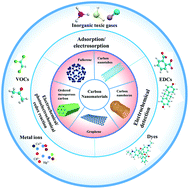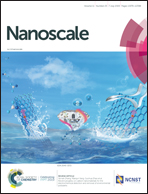Recent progress on carbon nanomaterials for the electrochemical detection and removal of environmental pollutants
Abstract
Rapid global industrialization and explosive population growth have resulted in an increase in the discharge of harmful and toxic compounds. These toxic inorganic gases, volatile organic compounds, heavy metals, personal care products, endocrine-disrupting chemicals, dyes, and pharmaceuticals are destroying the balance in the Earth and increasing environmental toxicity at an alarming rate. Thus, their detection, adsorption and removal are of great significance. Various carbon nanomaterials including carbon nanotubes, graphene, mesoporous carbon, carbon dots, and boron-doped diamond have been extensively utilized and further proven to be ideal candidates for resolving environmental problems, emerging as adsorbents, electrochemical sensors and electrodes. Herein, we review the recent advances, progress and achievements in the design and properties of carbon nanomaterials and their applications for the electrochemical detection and removal of environmental pollutants.

- This article is part of the themed collections: Nanocarbons and Recent Review Articles


 Please wait while we load your content...
Please wait while we load your content...